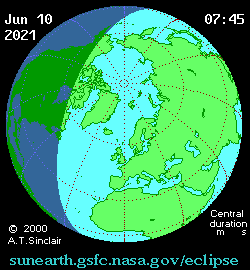Nature Annular Magnitude 0.9435 Max. width of band 527 km (327 mi) Start date June 10, 2021 | Gamma 0.9152 Duration 231 sec (3 m 51 s) Greatest eclipse 10:43:07 | |
 | ||
An annular solar eclipse will occur on June 10, 2021. A solar eclipse occurs when the Moon passes between Earth and the Sun, thereby totally or partly obscuring the image of the Sun for a viewer on Earth. An annular solar eclipse occurs when the Moon's apparent diameter is smaller than the Sun's, blocking most of the Sun's light and causing the Sun to look like an annulus (ring). An annular eclipse appears as a partial eclipse over a region of the Earth thousands of kilometres wide. This eclipse will be unusual as the path of the total eclipse will move to the north east, then north, north west, west, south west, south, and finally south east across the Arctic, while most eclipse paths move west to east. This reversal is only possible in polar regions.This eclipse is also notable for the fact that the path of annularity passes over the North Pole.
Contents
While the eclipse is visible primarily in the relatively unpopulated area near the Arctic Circle, in the northeastern United States and Canada, the sun will be partially eclipsed at sunrise.
Images
Animated path
Solar eclipses of 2018-2021
Each member in a semester series of solar eclipses repeats approximately every 177 days and 4 hours (a semester) at alternating nodes of the Moon's orbit.
Note: Partial solar eclipses on February 15, 2018, and August 11, 2018, occur during the previous semester series.
Metonic series
The metonic series repeats eclipses every 19 years (6939.69 days), lasting about 5 cycles. Eclipses occur in nearly the same calendar date. In addition the octon subseries repeats 1/5 of that or every 3.8 years (1387.94 days).
